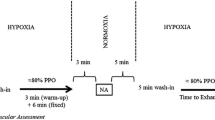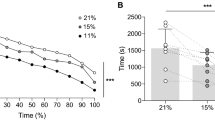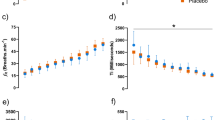Abstract
Purpose
We investigated whether caffeine consumption can enhance peak oxygen uptake (\({\dot{\text{V}}\text{O}}_{{\text{2peak}}}\)) by increasing peak ventilation during an incremental cycling test, and subsequently enhance time to exhaustion (TTE) during high-intensity cycling exercise in moderate normobaric hypoxia.
Methods
We conducted a double-blind, placebo cross-over design study. Sixteen recreational male endurance athletes (age: 20 ± 2 years, \({\dot{\text{V}}\text{O}}_{{\text{2peak}}}\): 55.6 ± 3.6 ml/kg/min, peak power output: 318 ± 40 W) underwent an incremental cycling test and a TTE test at 80% \({\dot{\text{V}}\text{O}}_{{\text{2peak}}}\) (derived from the placebo trial) in moderate normobaric hypoxia (fraction of inspired O2: 15.3 ± 0.2% corresponding to a simulated altitude of ~ 2500 m) after consuming either a moderate dose of caffeine (6 mg/kg) or a placebo.
Results
Caffeine consumption resulted in a higher peak ventilation [159 ± 21 vs. 150 ± 26 L/min; P < 0.05; effect size (ES) = 0.31]. \({\dot{\text{V}}\text{O}}_{{\text{2peak}}}\) (3.58 ± 0.44 vs. 3.47 ± 0.47 L/min; P < 0.01; ES = 0.44) and peak power output (308 ± 44 vs. 302 ± 44 W; P = 0.02, ES = 0.14) were higher following caffeine consumption than during the placebo trial. During the TTE test, caffeine consumption enhanced minute ventilation (P = 0.02; ES = 0.28) and extended the TTE (426 ± 74 vs. 358 ± 75 s; P < 0.01, ES = 0.91) compared to the placebo trial. There was a positive correlation between the percent increase of \({\dot{\text{V}}\text{O}}_{{\text{2peak}}}\) following caffeine consumption and the percent increase in TTE (r = 0.49, P < 0.05).
Conclusion
Moderate caffeine consumption stimulates breathing and aerobic metabolism, resulting in improved performance during incremental and high-intensity endurance exercises in moderate normobaric hypoxia.







Similar content being viewed by others
Data availability
As this data set are currently involving with multiple ongoing manuscripts, sharing this to public is therefore not available. However, data will be available upon request to the corresponding author.
Abbreviations
- CO2 :
-
Carbon dioxide
- O2 :
-
Oxygen
- \({\dot{\text{V}}\text{O}}_{{\text{2peak}}}\) :
-
Peak oxygen uptake
- RPE:
-
Ratings of perceived exertion
- TTE:
-
Time to exhaustion
- W:
-
Watts
References
Aguiar AS Jr, Speck AE, Canas PM, Cunha RA (2020) Neuronal adenosine A2A receptors signal ergogenic effects of caffeine. Sci Rep 10(1):13414. https://doi.org/10.1038/s41598-020-69660-1
Amann M, Hopkins WG, Marcora SM (2008) Similar sensitivity of time to exhaustion and time-trial time to changes in endurance. Med Sci Sports Exerc 40(3):574–578. https://doi.org/10.1249/MSS.0b013e31815e728f
Astorino TA, Cottrell T, Lozano AT, Aburto-Pratt K, Duhon J (2011) Ergogenic effects of caffeine on simulated time-trial performance are independent of fitness level. J Caffeine Res 1(3):179–185. https://doi.org/10.1089/jcr.2011.0022
Benoit H, Busso T, Castells J, Geyssant A, Denis C (2003) Decrease in peak heart rate with acute hypoxia in relation to sea level VO(2max). Eur J Appl Physiol 90(5–6):514–519. https://doi.org/10.1007/s00421-003-0899-y
Borg GA (1982) Psychophysical bases of perceived exertion. Med Sci Sports Exerc 14(5):377–381
Brown RA, Spina D, Page CP (2008) Adenosine receptors and asthma. Br J Pharmacol 153(S1):S446–S456. https://doi.org/10.1038/bjp.2008.22
Calbet JA, Boushel R, Rådegran G, Søndergaard H, Wagner PD, Saltin B (2003) Determinants of maximal oxygen uptake in severe acute hypoxia. Am J Physiol Regul Integr Comp Physiol 284(2):R291–R303
Calzetta L, Spina D, Cazzola M, Page CP, Facciolo F, Rendina EA, Matera MG (2011) Pharmacological characterization of adenosine receptors on isolated human bronchi. Am J Respir Cell Mol Biol 45(6):1222–1231. https://doi.org/10.1165/rcmb.2011-0056OC
Cao Y, Fujii N, Fujimoto T, Lai YF, Ogawa T, Hiroyama T, Enomoto Y, Nishiyasu T (2022) CO2-enriched air inhalation modulates the ventilatory and metabolic responses of endurance runners during incremental running in hypobaric hypoxia. High Alt Med Biol 23(2):125–134. https://doi.org/10.1089/ham.2021.0114
Cao Y, Ichikawa Y, Sasaki Y, Ogawa T, Hiroyama T, Enomoto Y, Fujii N, Nishiyasu T (2019) Expiratory flow limitation under moderate hypobaric hypoxia does not influence ventilatory responses during incremental running in endurance runners. Physiol Rep 7(3):e13996. https://doi.org/10.14814/phy2.13996
Carrillo JA, Benitez J (2000) Clinically significant pharmacokinetic interactions between dietary caffeine and medications. Clin Pharmacokinet 39(2):127–153
Chapman RF (2013) The individual response to training and competition at altitude. Br J Sports Med 47(Suppl 1):i40-44. https://doi.org/10.1136/bjsports-2013-092837
Chapman RF, Stager JM (2008) Caffeine stimulates ventilation in athletes with exercise-induced hypoxemia. Med Sci Sports Exerc 40(6):1080–1086. https://doi.org/10.1249/MSS.0b013e3181667421
Chapman RF, Stager JM, Tanner DA, Stray-Gundersen J, Levine BD (2011) Impairment of 3000-m run time at altitude is influenced by arterial oxyhemoglobin saturation. Med Sci Sports Exerc 43(9):1649–1656. https://doi.org/10.1249/MSS.0b013e318211bf45
Chester N, Wojek N (2008) Caffeine consumption amongst British athletes following changes to the 2004 WADA prohibited list. Int J Sports Med 29(06):524–528
Cohen J (2013) Statistical power analysis for the behavioral sciences. Routledge
Conde SV, Ribeiro MJ, Obeso A, Rigual R, Monteiro EC, Gonzalez C (2012) Chronic caffeine intake in adult rat inhibits carotid body sensitization produced by chronic sustained hypoxia but maintains intact chemoreflex output. Mol Pharmacol 82(6):1056–1065. https://doi.org/10.1124/mol.112.081216
Del Coso J, Muñoz G, Muñoz-Guerra J (2011) Prevalence of caffeine use in elite athletes following its removal from the World Anti-Doping Agency list of banned substances. Appl Physiol Nutr Metab 36(4):555–561
Dempsey JA, Amann M, Romer LM, Miller JD (2008) Respiratory system determinants of peripheral fatigue and endurance performance. Med Sci Sports Exerc 40(3):457–461. https://doi.org/10.1249/MSS.0b013e31815f8957
Desbrow B, Biddulph C, Devlin B, Grant GD, Anoopkumar-Dukie S, Leveritt MD (2012) The effects of different doses of caffeine on endurance cycling time trial performance. J Sports Sci 30(2):115–120. https://doi.org/10.1080/02640414.2011.632431
Doherty M, Smith PM (2005) Effects of caffeine ingestion on rating of perceived exertion during and after exercise: a meta-analysis. Scand J Med Sci Sports 15(2):69–78. https://doi.org/10.1111/j.1600-0838.2005.00445.x
Durand F, Mucci P, Préfaut C (2000) Evidence for an inadequate hyperventilation inducing arterial hypoxemia at submaximal exercise in all highly trained endurance athletes. Med Sci Sports Exerc 32(5):926–932. https://doi.org/10.1097/00005768-200005000-00008
D’Urzo AD, Jhirad R, Jenne H, Avendano MA, Rubinstein I, D’Costa M, Goldstein RS (1990) Effect of caffeine on ventilatory responses to hypercapnia, hypoxia, and exercise in humans. J Appl Physiol 68(1):322–328
Fan JL, Kayser B (2016) Fatigue and exhaustion in hypoxia: the role of cerebral oxygenation. High Alt Med Biol 17(2):72–84. https://doi.org/10.1089/ham.2016.0034
Flueck JL, Schaufelberger F, Lienert M, Schafer Olstad D, Wilhelm M, Perret C (2016) Acute effects of caffeine on heart rate variability, blood pressure and tidal volume in paraplegic and tetraplegic compared to able-bodied individuals: a randomized, blindede trial. PLos ONE 11(10):e0165034. https://doi.org/10.1371/journal.pone.0165034
Fulco CS, Rock PB, Trad LA, Rose MS, Forte VA, Young PM, Cymerman A (1994) Effect of caffeine on submaximal exercise performance at altitude. Aviat Space Environ Med 65(6):539–545
Gavin TP, Derchak PA, Stager JM (1998) Ventilation’s role in the decline in VO2max and SaO2 in acute hypoxic exercise. Med Sci Sports Exerc 30(2):195–199. https://doi.org/10.1097/00005768-199802000-00004
Guest NS, VanDusseldorp TA, Nelson MT, Grgic J, Schoenfeld BJ, Jenkins NDM, Arent SM, Antonio J, Stout JR, Trexler ET, Smith-Ryan AE, Goldstein ER, Kalman DS, Campbell BI (2021) International society of sports nutrition position stand: caffeine and exercise performance. J Int Soc Sports Nutr 18(1):1. https://doi.org/10.1186/s12970-020-00383-4
Howell LL, Coffin VL, Spealman RD (1997) Behavioral and physiological effects of xanthines in nonhuman primates. Psychopharmacology 129(1):1–14. https://doi.org/10.1007/s002130050155
Knaier R, Infanger D, Niemeyer M, Cajochen C, Schmidt-Trucksass A (2019) In athletes, the diurnal variations in maximum oxygen uptake are more than twice as large as the day-to-day variations. Front Physiol 10:219. https://doi.org/10.3389/fphys.2019.00219
Laursen PB, Francis GT, Abbiss CR, Newton MJ, Nosaka K (2007) Reliability of time-to-exhaustion versus time-trial running tests in runners. Med Sci Sports Exerc 39(8):1374–1379. https://doi.org/10.1249/mss.0b013e31806010f5
Levine BD (2008) VO2max: what do we know, and what do we still need to know? J Physiol 586(1):25–34. https://doi.org/10.1113/jphysiol.2007.147629
Lopez-Barneo J, Gonzalez-Rodriguez P, Gao L, Fernandez-Aguera MC, Pardal R, Ortega-Saenz P (2016) Oxygen sensing by the carotid body: mechanisms and role in adaptation to hypoxia. Am J Physiol Cell Physiol 00265:02015. https://doi.org/10.1152/ajpcell.00265.2015
Mathew OP (2011) Apnea of prematurity: pathogenesis and management strategies. J Perinatol 31(5):302–310. https://doi.org/10.1038/jp.2010.126
McKay AKA, Stellingwerff T, Smith ES, Martin DT, Mujika I, Goosey-Tolfrey VL, Sheppard J, Burke LM (2022) Defining training and performance caliber: a participant classification framework. Int J Sports Physiol Perform 17(2):317–331. https://doi.org/10.1123/ijspp.2021-0451
Neyroud D, Cheng AJ, Donnelly C, Bourdillon N, Gassner A-L, Geiser L, Rudaz S, Kayser B, Westerblad H, Place N (2019) Toxic doses of caffeine are needed to increase skeletal muscle contractility. Am J Physiol Cell Physiol 316(2):C246–C251. https://doi.org/10.1152/ajpcell.00269.2018
Olcina G, Munoz D, Kemp J, Timon R, Maynar J, Caballero MJ, Maynar M (2012) Total plasma fatty acid responses to maximal incremental exercise after caffeine ingestion. J Exerc Sci Fit 10(1):33–37
Pallares JG, Fernandez-Elias VE, Ortega JF, Munoz G, Munoz-Guerra J, Mora-Rodriguez R (2013) Neuromuscular responses to incremental caffeine doses: performance and side effects. Med Sci Sports Exerc 45(11):2184–2192. https://doi.org/10.1249/MSS.0b013e31829a6672
Pasman WJ, van Baak MA, Jeukendrup AE, de Haan A (1995) The effect of different dosages of caffeine on endurance performance time. Int J Sports Med 16(4):225–230. https://doi.org/10.1055/s-2007-972996
Plaskett CJ, Cafarelli E (2001) Caffeine increases endurance and attenuates force sensation during submaximal isometric contractions. J Appl Physiol 91(4):1535–1544. https://doi.org/10.1152/jappl.2001.91.4.1535
Rice A, Scroop G, Thornton A, McNaughton N, Rogers K, Chapman M, Greville H, Scicchitano R, Gore C (2000) Arterial hypoxaemia in endurance athletes is greater during running than cycling. Respir Physiol 123(3):235–246
Sahn SA, Zwillich CW, Dick N, McCullough RE, Lakshminarayan S, Weil JV (1977) Variability of ventilatory responses to hypoxia and hypercapnia. J Appl Physiol 43(6):1019–1025. https://doi.org/10.1152/jappl.1977.43.6.1019
Sawynok J (2016) Adenosine receptor targets for pain. Neuroscience 338:1–18. https://doi.org/10.1016/j.neuroscience.2015.10.031
Silva-Cavalcante MD, Correia-Oliveira CR, Santos RA, Lopes-Silva JP, Lima HM, Bertuzzi R, Duarte M, Bishop DJ, Lima-Silva AE (2013) Caffeine increases anaerobic work and restores cycling performance following a protocol designed to lower endogenous carbohydrate availability. PLoS ONE 8(8):e72025. https://doi.org/10.1371/journal.pone.0072025
Silveira R, Andrade-Souza VA, Arcoverde L, Tomazini F, Sansonio A, Bishop DJ, Bertuzzi R, Lima-Silva AE (2017) Caffeine increases work done above critical power, but not anaerobic work. Med Sci Sports Exerc
Smirmaul BP, de Moraes AC, Angius L, Marcora SM (2017) Effects of caffeine on neuromuscular fatigue and performance during high-intensity cycling exercise in moderate hypoxia. Eur J Appl Physiol 117(1):27–38. https://doi.org/10.1007/s00421-016-3496-6
Smith CA, Bisgard GE, Nielsen AM, Daristotle L, Kressin NA, Forster HV, Dempsey JA (1986) Carotid bodies are required for ventilatory acclimatization to chronic hypoxia. J Appl Physiol 60(3):1003–1010. https://doi.org/10.1152/jappl.1986.60.3.1003
Spriet L, MacLean D, Dyck D, Hultman E, Cederblad G, Graham T (1992) Caffeine ingestion and muscle metabolism during prolonged exercise in humans. Am J Physiol Endocrinol Metab 262(6):E891–E898
Stadheim HK, Kvamme B, Olsen R, Drevon CA, Ivy JL, Jensen J (2013) Caffeine increases performance in cross-country double-poling time trial exercise. Med Sci Sports Exerc 45(11):2175–2183. https://doi.org/10.1249/MSS.0b013e3182967948
Stadheim HK, Nossum EM, Olsen R, Spencer M, Jensen J (2015) Caffeine improves performance in double poling during acute exposure to 2,000-m altitude. J Appl Physiol 119(12):1501–1509. https://doi.org/10.1152/japplphysiol.00509.2015
Stadheim HK, Stensrud T, Brage S, Jensen J (2021) Caffeine increases exercise performance, maximal oxygen uptake, and oxygen deficit in elite male endurance athletes. Med Sci Sports Exerc
Acknowledgements
We sincerely thank the participants for their time and efforts to participate in this study.
Funding
This study was supported by research project of Shanghai University of Sport (grant number: 2022XJ020) and supported by Shanghai Key Lab of Human Performance at Shanghai University of Sport (grant number: 11DZ2261100).
Author information
Authors and Affiliations
Contributions
L.Z., Q.Q., G.O., W.R., G.L. and C.Y. conceived and designed experiments; L.Z., Q.Q. and C.Y. contributed to data collection; L.Z., Q.Q. and C.Y. performed data analysis. L.Z., Q.Q., G.O., M.T., W.R., G.L. and C.Y. interpreted the experimental results; C.Y. prepared figures; L.Z. drafted manuscript; L.Z., G.O., M.T. and C.Y. edited and revised the manuscript; all authors approved the final version of the manuscript; all experiments took place at the School of Athletic Performance located at the Shanghai University of Sport, China.
Corresponding author
Ethics declarations
Conflict of interest
There are no conflicts of interest in the present study.
Additional information
Communicated by Susan Hopkins .
Publisher's Note
Springer Nature remains neutral with regard to jurisdictional claims in published maps and institutional affiliations.
Rights and permissions
Springer Nature or its licensor (e.g. a society or other partner) holds exclusive rights to this article under a publishing agreement with the author(s) or other rightsholder(s); author self-archiving of the accepted manuscript version of this article is solely governed by the terms of such publishing agreement and applicable law.
About this article
Cite this article
Lei, TH., Qin, Q., Girard, O. et al. Caffeine intake enhances peak oxygen uptake and performance during high-intensity cycling exercise in moderate hypoxia. Eur J Appl Physiol 124, 537–549 (2024). https://doi.org/10.1007/s00421-023-05295-0
Received:
Accepted:
Published:
Issue Date:
DOI: https://doi.org/10.1007/s00421-023-05295-0




